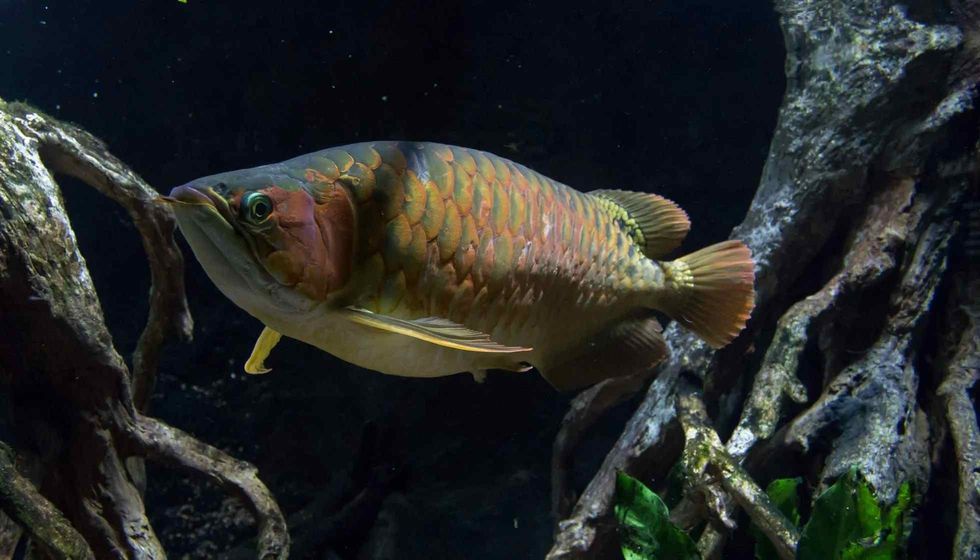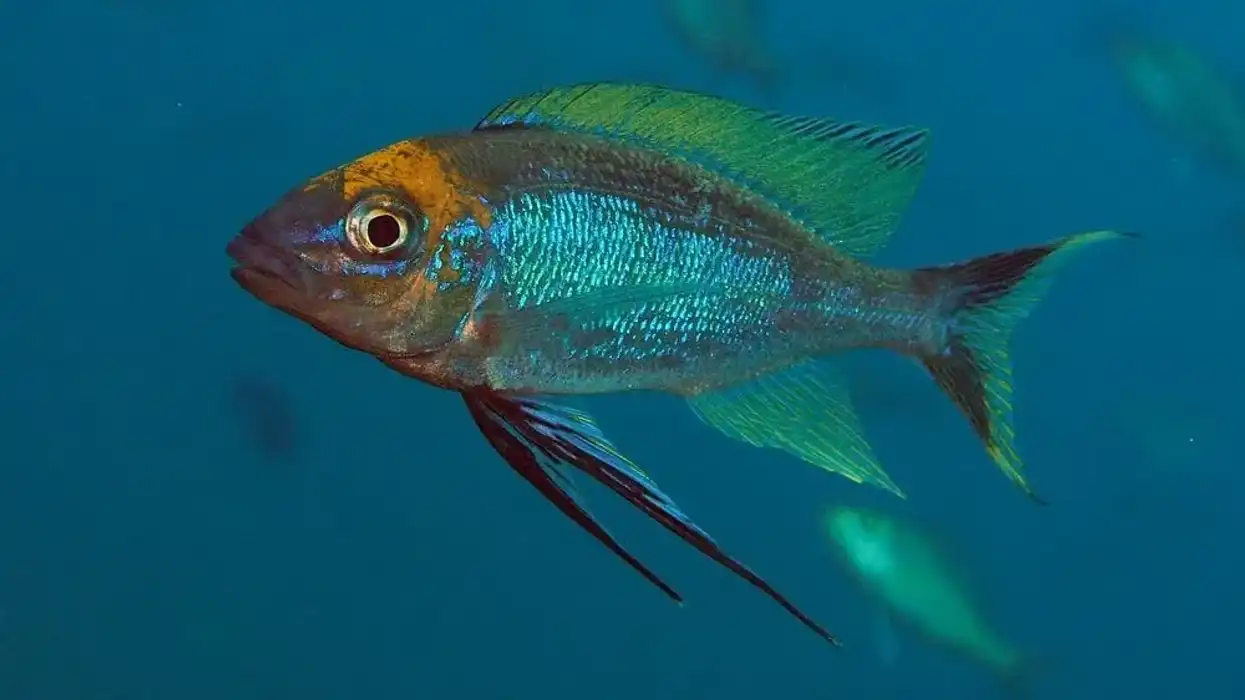Would you like to learn about special species of fish that have been around since the time dinosaurs walked the earth? This article will tell you everything you need to know about them!
The African arowana belongs to one of the most unique and ancient species of freshwater fish known as 'bony tongues. The name bony tongues are given to the species due to the teeth on its tongue, that clash with the teeth present on the upper side of the fish's mouth.
It belongs to the Osteoglossidae family and is a genus of Heterotis.
Even though the fish is called arowana, they are closely related to arapaimas, species belonging to the Arapaiminae family than to other arowanas from the Osteoglossidae family, a species from South America and Asia. Its scientific name Heterotis niloticus is given by Georges Cuvier, a French zoologist, and naturalist, in 1829.
The African arowana (Heterotis niloticus) can be found in freshwater bodies across the African continent. These fish are known to filter feed, searching through murky, or sandy waters for food.
African arowanas are large, aggressive fishes covered with large scales, several fins like any other fishes including the dorsal and anal fin situate at the back of its body, the ventral, and the caudal fin. In many cultures, it is believed that arowanas bring good luck and fortune to their owners.
They accept rich, meaty foods several times per day including small fish, insects, and planktons.
You can install a plankton and filter feeder to solve that. A temperature of 75-86° F (24-30°C) is also ideal for their living.
For similar content, check out our articles on herring and catfish too.
African Arowana Interesting Facts
What type of animal is an African arowana?
The African arowana is a fish belonging to the Animalia kingdom. They are easy pets to keep and accept meaty foods several times a day.
What class of animal does an African arowana belong to?
The African arowana belongs to the Actinopterygii class.
How many African arowana are there in the world?
Accurate popluation size of the African arowana species is unknown.
Where does an African arowana live?
African arowana (Heterotis niloticus) can be found throughout Africa, it is endemic to the watersheds of Sahelo-Sudanese, Senegal, and the Gambia, as well as some parts of eastern Africa.
What is an African arowana's habitat?
The African arowana fish habitat includes freshwater bodies, rivers, lakes, ponds, and river basins they tend to inhabit shallow rivers or stream banks close to reeds or other vegetation.
Who do African arowana live with?
African arowanas (Heterotis niloticus) are solitary fish and only allow company while young; adults may show dominance and aggression.
How long does an African arowana live?
An African arowana (Heterotis niloticus) can live up to 5-10 years.
How do they reproduce?
African arowana (Heterotis niloticus) reach sexual maturity at the age of three to four years. They reproduce via sexual reproduction and external fertilization, or spawning.
The male and female species build a circular nest to lay a batch of 30 - 100 eggs before the breeding season, the nest is complete in four to seven days.
The female releases her eggs in the nest and leaves temporarily so that the male can go ahead and fertilize them.
When the nests containing newly hatch larvae are disturbed or prone to any danger, both parents carry the young larvae in their mouth and transport them to a new and safer location. Young juveniles disperse from the nest at six months and migrate to open waters.
What is their conservation status?
The IUNC Red List of Threatened Species has classified The African arowana (Heterotis niloticus) as species of Least Concern.
African Arowana Fun Facts
What do African arowana look like?
The African arowana (Heterotis niloticus) is a long-bodied fish with a toothed tongue, a large mouth with an oblique gape, long dorsal and anal fins placed far back on its body, and a fairly round caudal fin. An adult African arowana fish is gray, bronze-brown in color, whereas young juveniles display dark longitudinal stripes.
These fish are covered with mosaic-like scales except their head.

*Please note that this is an image of a red Asian arowana. If you have an image of an African arowana, please let us know at hello@kidadl.com.
How cute are they?
This fish isn't cute, but they are not ugly either.
How do they communicate?
African arowanas (Heterotis niloticus) have two large whisker-like features that are called barbels, which have sensory functions and help them in communication. They are placed at the bottom of their lower jaw.
Barbels help these fishes navigate and find potential prey in nearby waters, foods like small insects, shrimps, worms, are included in their diet.
This fish has great vision and so, it is no problem for them to go looking for their diet or communicate as required with the help of their eyesight. However, these fish can even prey or hunt for their food in the dark without any vision, thanks to the highly developed barbels.
Communication among arowanas also occurs through electronic signals which are emitted from a set of specific muscles present in some species of this fish.
How big is an African arowana?
African Arowana (Heterotis niloticus) can grow up to 39.6 in (100 cm) in size. In fact, all arowana species grow up to the same size. There is no such thing as the smallest arowana, but the Asian arowana is a little bit smaller and measures 36 in (91 cm).
A horn shark is the same size as an adult African arowana.
How fast can an African arowana swim?
The speed of an African arowana is unknown. However, they are powerful and strong swimmers.
How much does an African arowana weigh?
An African arowana weighs up to 22 lb (10.2 kg). They are typically larger in size.
What are the male and female names of the species?
There are no separate names for the male and female African arowana fish. They are simply denoted as males and females.
What would you call a baby African arowana?
The baby of this freshwater fish is called a fry.
What do they eat?
African arowanas are carnivorous and great predators. They eat a variety of creatures like krill, shrimp, small fish, insects, plankton and filter feeder (juvenile fish) accept meaty foods like live worms and small fish.
Are they dangerous?
Yes, these fish can be dangerous. Their aggressive behavior got them nicknamed 'monster fishes'. These fishes consume anything that fits in their mouth. They pose as threats to small fish species as well as their own.
They are very territorial and often engage in fights to keep other fish away. These fishes have also attacked and bitten humans before. They are aggressive almost all the time, even during the breeding process.
The Australian arowanas (Jardini arowana) are the most aggressive among the Osteoglossidae family.
Would they make a good pet?
They would make great pets but they are quite expensive. Purchasing the fish alone may cost up to $200.
If you decide to keep them as pets make sure the tank has a capacity of at least 80-120 gallons, the length of the tank should be around (45-152 cm). Make sure the tank is well-covered and has a dark color or theme.
You can decorate the tank with plants. sand, small rocks, and pebbles.
The water temperature should be between 75-86° F (24-30°C). The species prefer living alone, any small fish kept in the same tank will get eaten. We recommend keeping them in a separate tank, on their own.
If you do want to add other fishes to accompany we suggest adding fishes of similar size such as large mormyrids, leporinus, pacus, silver dollars, and knifefish make good tank mates. Feeding adult arowanas is easy however juvenile fish are filter feeders that require large amounts of tiny food items like live brine or micro worms.
They have to be fed rich, meaty foods several times per day. You can install a plankton and filter feeder to solve that.
Did you know...
Common names of the African arowana (Heterotis niloticus) include the African bony tongue and the Nile arowana. Some other species such as the Asian arowanas are named 'dragon fish' for their striking colors. Other binominal names such as Sudis niloticus and Clupisudis niloticus are also assigned to the species.
About five extinct genera are classified as osteoglossids that date back as far as the late cretaceous. Some fossils of this fish family date back to the late Jurassic.
When pet arowanas feel anxious they bang against their tank walls and often jump out of their tank, if it's not covered properly.
African arowanas lay amber yellow-colored eggs.
Arowanas are banned in the United States as some of the species are classified as Near Threatened or Vulnerable.
Why are arowana so expensive?
The African arowana unlike the Asian and South American arowana species, is one of its kind and therefore very expensive.
Does arowana fish bite?
Yes, they do. These fishes usually bite their owners when they are being fed.
Here at Kidadl, we have carefully created lots of interesting family-friendly animal facts for everyone to discover! For more relatable content, check out these skate fish facts or angelfish facts pages.
You can even occupy yourself at home by coloring one of our free printable Arowana coloring pages.










